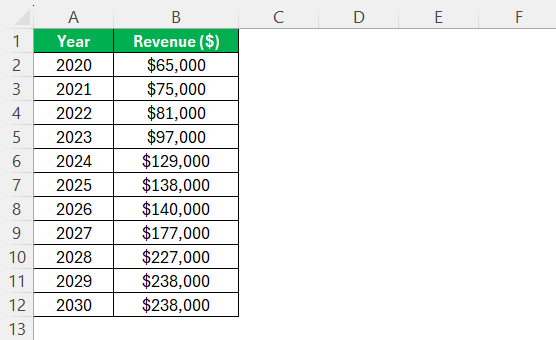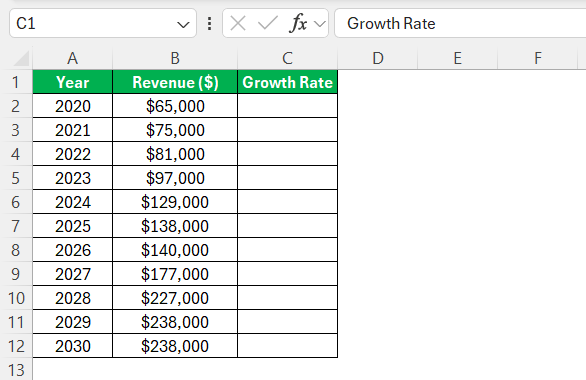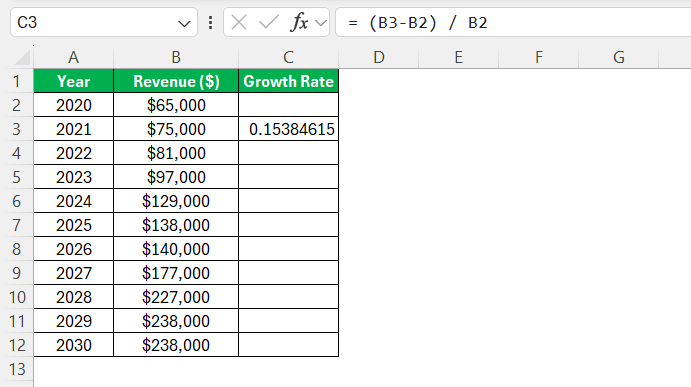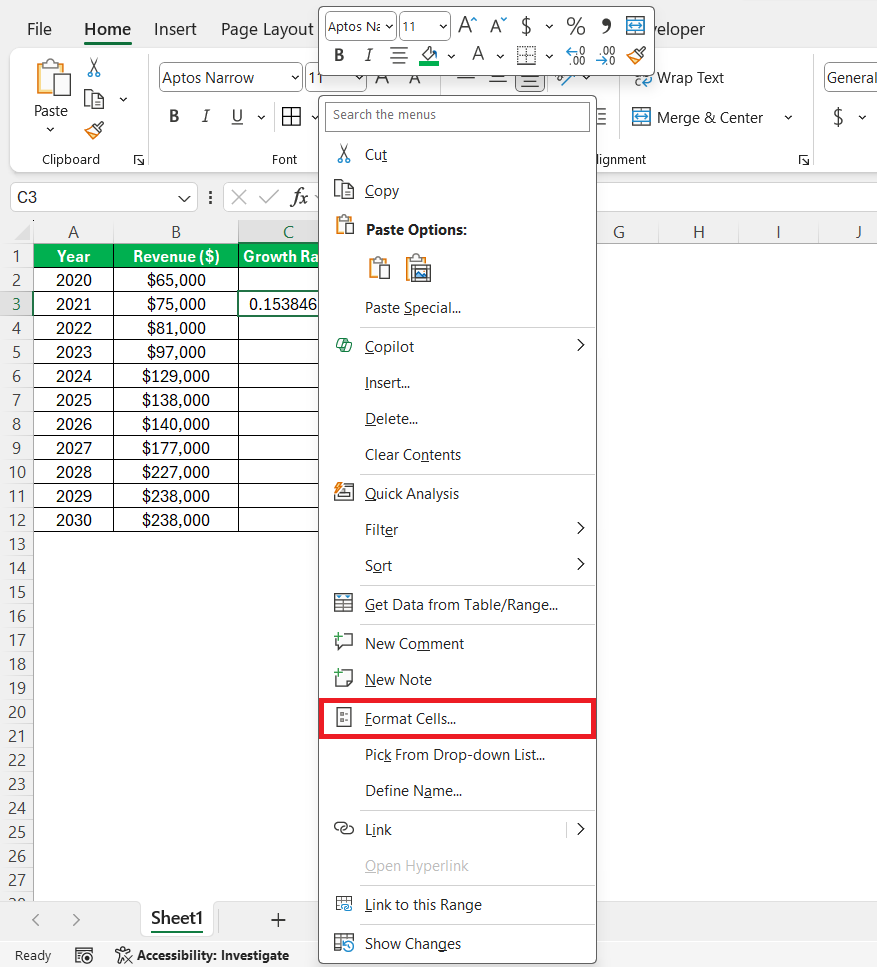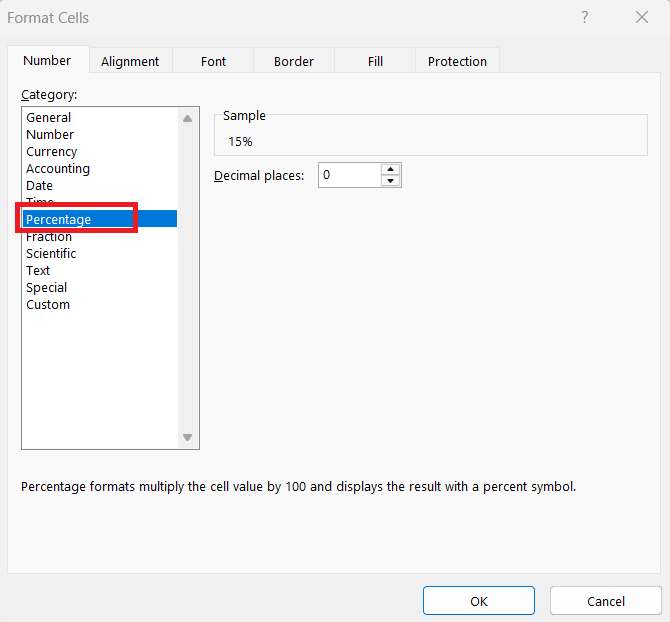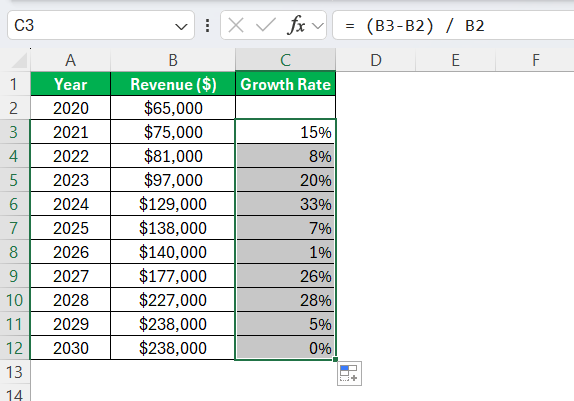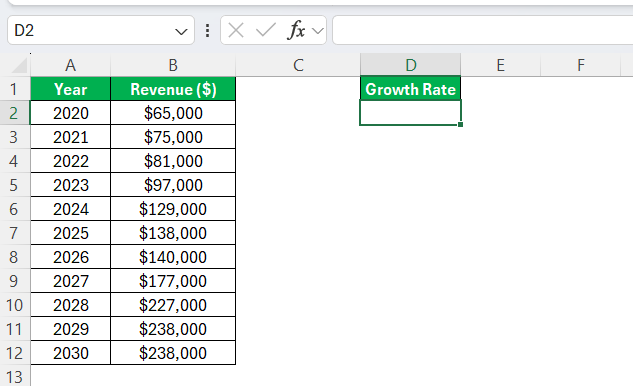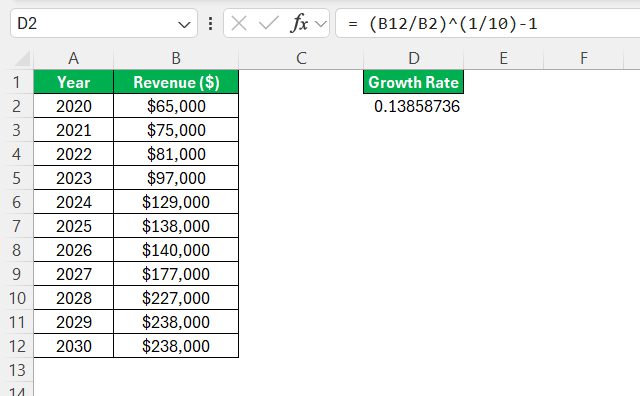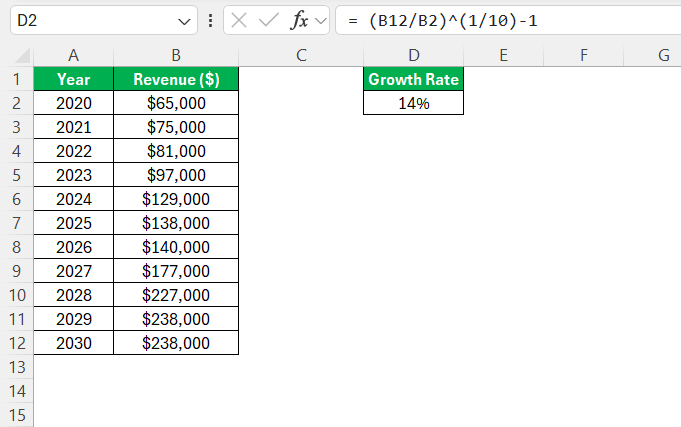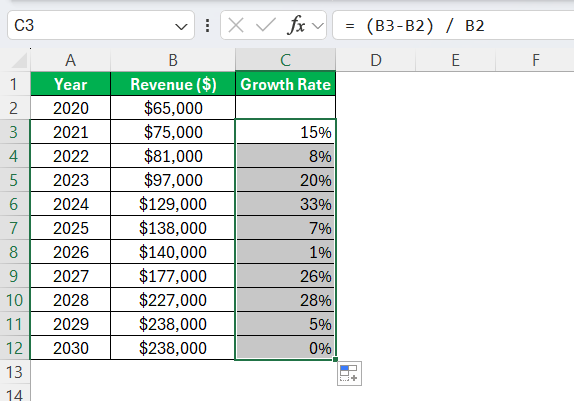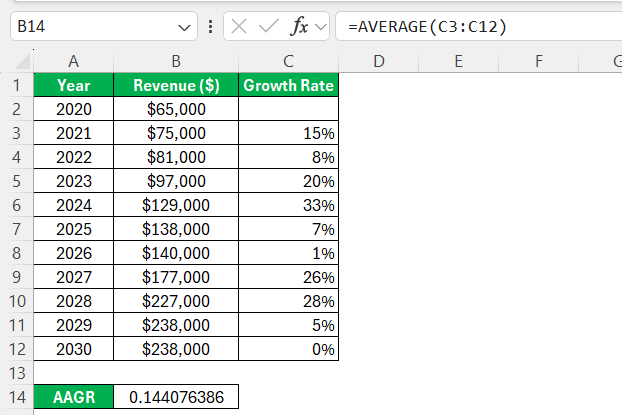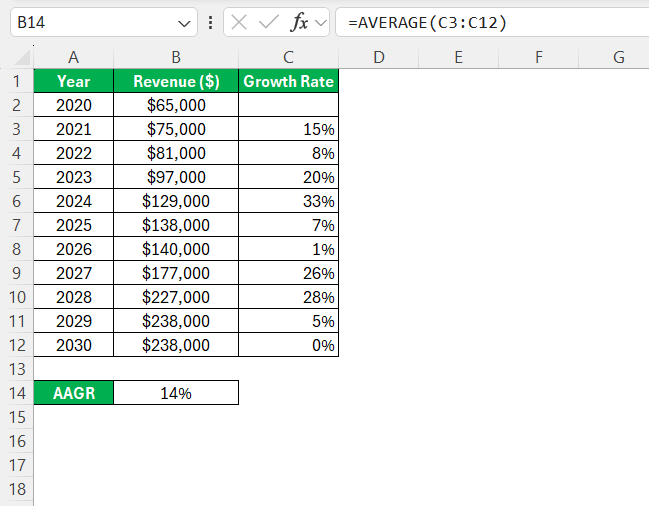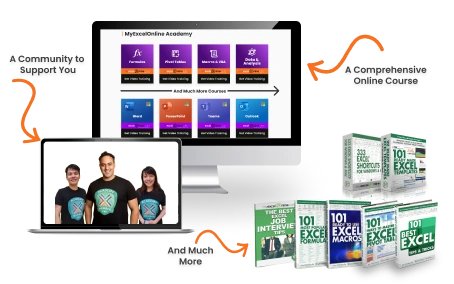Mastering the growth rate formula in Excel can transform raw data into actionable insights, crucial for decision-making in various sectors. It’s an accessible tool, loved for its versatility and ability to visualize future trends, making it essential for both novice and experienced users. Understanding how to apply and interpret growth rate formula in Excel properly can unveil patterns and predict potential outcomes, paving the way for strategic planning and increased efficiency.
Key Takeaways:
- Growth rates in Excel help analyze data trends, supporting strategic planning and decision-making.
- The basic growth rate formula divides the difference between end and start values by the start value.
- CAGR provides a smoothed annual growth rate, while AAGR offers a simple average of yearly growth rates.
- Organizing data properly in tables ensures accuracy when applying Excel growth rate formulas.
- Excel functions like CAGR and AVERAGE streamline growth rate calculations for better insights.
Table of Contents
Unraveling the Growth Rate Formula
Understanding the Basics of Growth Rates
Growth rates measure the rate at which a particular variable changes over a specified time period. They are pivotal in contexts ranging from economic analysis to corporate finance, providing insights into how quickly a company or economy is expanding. To compute a basic growth rate, the difference between the end value and the start value is divided by the start value, then multiplied by 100 to express it as a percentage.
This process highlights how much a variable has increased or decreased, reflecting its trend over time. Recognizing these fundamental concepts enables better analysis and understanding of growth patterns in your datasets.
Types of Growth Rates in Business
In business, understanding different types of growth rates can provide nuanced insights into performance and strategic direction. Two primary types of growth rates commonly analyzed are the Compound Annual Growth Rate (CAGR) and the Average Annual Growth Rate (AAGR).
- Compound Annual Growth Rate (CAGR): CAGR is a more complex metric that signifies the mean annual growth rate of an investment over a specified time period longer than one year. It assumes profits are reinvested and provides a smoothed annual rate, which is beneficial for evaluating historical growth and forecasting future performance.
- Average Annual Growth Rate (AAGR): AAGR provides a straightforward average of yearly growth rates. While it can indicate a general trend, it does not account for the compounding effects present in CAGR, making it less accurate for predicting future performance over multiple periods.
Businesses often use these growth rates in combination to get a holistic view of their progress and potential. Each measure serves a unique purpose, with AAGR giving a simple average growth rate and CAGR offering more insights into long-term growth performance and compound effects. Employing both can help in making informed strategic decisions and financial planning.
Step-by-Step Guide to Using the Growth Rate Formula in Excel
Preparing Your Data for Analysis
Before diving into growth rate calculations in Excel, organizing your data is crucial. Proper preparation ensures accurate analysis and meaningful results. Follow these steps to set up your data effectively:
- Collect Historical Data: Gather data over the period you wish to analyze. This data should be consistent and relevant to the growth metric you aim to calculate.
- Structure Data in a Table: Use Excel or Google Sheets to create a structured table. Label your columns clearly, typically with time periods as headers (e.g., months or years) and the corresponding values below.
- Ensure Consistent Formatting: Double-check that your data is formatted consistently. This means using uniform decimal places, date formats, and data types throughout your dataset.
- Verify Data Accuracy: Cross-check the values for any discrepancies or outliers that might skew the results. Remove any errors or anomalies that could impact the calculations.
- Add Descriptive Headers: Label each column appropriately for clarity, ensuring anyone reviewing the worksheet can easily understand what each set of data represents.
With organized and prepared data, you’ll be better positioned to accurately apply growth rate formulas and derive insightful trends and forecasts. Proper setup lays the groundwork for effective and efficient analysis.
Applying the Growth Rate Formula
After preparing your data, it’s time to apply the growth rate formula in Excel to uncover insights. Here’s a step-by-step guide on how to do it:
STEP 1: Start by adding a new column called Growth Rate.
STEP 2: To find the growth rate between two periods, use the formula:
= (Ending Value - Starting Value) / Starting Value
Enter this formula in a new cell where you want the result displayed. For instance, if you’re calculating the growth from cell B2 to B3, write:
= (B3-B2) / B2
STEP 3: Format the result cell to show the growth rate as a percentage. Right-click the cell, choose ‘Format Cells’.
STEP 4: Select ‘Percentage,’ and set the desired number of decimal places.
STEP 5: If you need to calculate the growth rate for several consecutive periods, drag the formula down across the row or column. Ensure your cell references adjust correctly, typically by dragging the fill handle (the small square at the corner of the selected cell).
Review your results for accuracy, ensuring there are no errors in cell references or data entry. This step is crucial for maintaining the integrity of your analysis.
Employing these steps, you can effectively calculate growth rates across various time frames, gaining valuable insights into the performance and trends of your data. This process not only highlights growth patterns but also supports strategic planning by providing quantifiable metrics.
Advanced Techniques for Growth Rate Calculation
Using the CAGR Function in Excel
Calculating the Compound Annual Growth Rate (CAGR) in Excel provides a precise evaluation of an investment’s average annual growth over a specific timeframe, assuming reinvestment of profits. To leverage Excel’s capabilities efficiently, follow these steps:
STEP 1: Arrange your starting and ending values in separate cells. Let’s assume the starting value is in cell B2 and the ending value is in cell B12.
STEP 2: Click on a cell where you would like the CAGR result to appear. This could be any convenient location on your sheet, say cell D2.
STEP 3: Type the following formula directly into the selected cell:
= (B12/B2)^(1/10)-1
In this formula, adjust the ’10’ to correspond to the number of periods in your data (one less than the total number of data points).
STEP 4: Change the format of the result cell to percentage by right-clicking, selecting ‘Format Cells,’ then choosing ‘Percentage.’ This conversion offers a clear representation of the CAGR.
Using Excel’s functionalities to calculate CAGR streamlines data processing, allowing for advanced financial and investment analyses. This method’s precision aids investors and analysts in understanding long-term growth rates, supporting informed decision-making and strategic planning.
Exploring AAGR for More Insight
The Average Annual Growth Rate (AAGR) offers a more straightforward metric to quantify average growth over time compared to the CAGR. Though it lacks the nuance of compounding, AAGR is beneficial for quick assessments of growth trends across simple datasets. Here’s how to explore AAGR using Excel:
STEP 1: Calculate the individual annual growth rates for each consecutive period. Use the formula:
= (Current Year Value - Previous Year Value) / Previous Year Value
STEP 2: Use Excel’s AVERAGE function to compute the mean of these yearly growth rates. In a new cell, enter:
= AVERAGE(C3:C12)
STEP 3: Format the result cell as a percentage for a more intuitive understanding of the AAGR.
This format provides a clear snapshot of average growth per year across the dataset.
By employing AAGR, businesses and analysts can attain a quick overview of performance without complexcalculations. It is particularly useful for datasets where individual yearly performance trends are of prime interest, helping to inform broader strategic decisions.
FAQs
How do you calculate growth rate in Excel?
To calculate the growth rate in Excel, use the formula: (Ending Value - Starting Value) / Starting Value. This computes the basic growth rate as a percentage. Simply enter this formula in a new cell, replacing “Ending Value” and “Starting Value” with the specific cell references of your data.
What is the difference between CAGR and AAGR?
CAGR provides a smoothed annual growth rate assuming steady compounding over time, ideal for long-term analysis. AAGR averages annual growth rates without compounding, offering a straightforward measure of year-to-year performance useful for spotting short-term trends.
How do I correct errors in my Excel growth rate calculations?
To correct errors in Excel growth rate calculations, verify that cell references in formulas are accurate and updated correctly. Ensure consistent data formatting, cross-check for any missing or incorrect data entries, and confirm the use of appropriate formulas for the specific growth rate type you’re calculating.
Can I calculate growth rates using Excel macros?
Yes, you can use Excel macros to automate growth rate calculations. By recording a macro, you can automate repetitive tasks, such as applying growth rate formulas across multiple datasets. This helps streamline the process, reduce errors, and save time, especially when handling large datasets or performing frequent analyses.
Is there a formula for CAGR in Excel?
Yes, you can calculate CAGR in Excel using the formula: =(Ending Value/Starting Value)^(1/Number of Periods)-1. Enter this formula directly into a cell, replacing “Ending Value,” “Starting Value,” and “Number of Periods” with their respective cell references or values to compute the CAGR.
John Michaloudis is a former accountant and finance analyst at General Electric, a Microsoft MVP since 2020, an Amazon #1 bestselling author of 4 Microsoft Excel books and teacher of Microsoft Excel & Office over at his flagship MyExcelOnline Academy Online Course.

